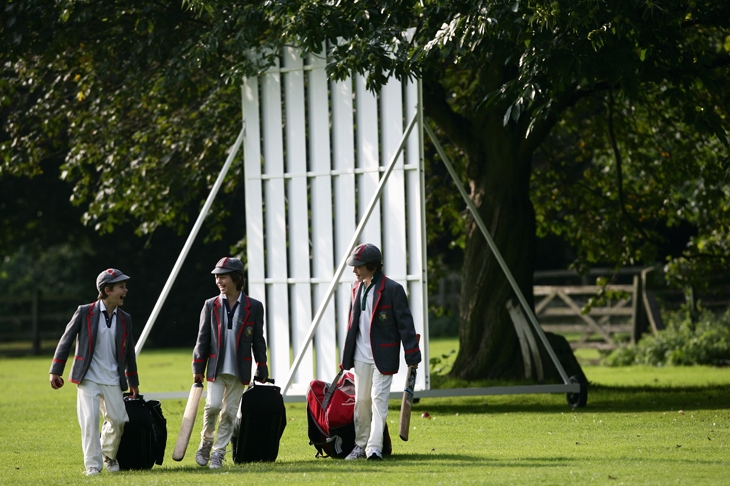In downstairs loos of houses of a certain sort, the old school photograph is a constant. When you’ve seen a few of these slightly yellowing portraits, you’ve seen them all. But this trend might soon reach its end. If you listen carefully in particular enclaves, you’ll hear faint whisperings about a new way of doing things. Maybe, just maybe, public school isn’t quite for everyone any more. Say goodbye to the old school pictures; the toffs are going native.
Last year, in a Viscount’s kitchen, I spotted an invitation to a school fair — at the local primary. A few weeks later, an Old Harrovian whose family has a 300-year history with the school remarked that he’d be preparing his children for the 11-plus, rather than common entrance. The aristocracy is stirring. While the matriarch of one big Scottish family may be content to send her sons 400 miles away to school in the south, a consensus is forming that this is no longer the only ‘done thing’.
It’s not entirely surprising. After all, being and sounding posh is out of fashion: the Bullingdon Club is struggling to recruit members, and, once again, ‘Etonian’ is used as a four-letter word. For one Old Etonian banker in his fifties, the idea that his school is some kind of prize is laughable. ‘When I was there it was a comprehensive for the landed gentry. Everyone east of the A1 went to Eton, and anyone west of the A1 went to Harrow.’
The rise in school fees — and as a result, the altered demographics — has changed this. In 1994, fees for Eton were £3,978; now, they’re £38,730 without the trimmings. Yearly boarding fees for Dulwich College, the most expensive school in the country, come in at a staggering £41,040. To send a trio of children to board for senior school at Dulwich, at today’s rates, would set one back £861,840. ‘The idea that I could afford that,’ scoffs a doctor who attended Uppingham, ‘is absurd.’
Heads appreciate this, even if they’re unable to make changes. ‘Fee increases have priced out a slice of the professional classes who would have looked to boarding schools as an obvious choice,’ says Leo Winkley, headmaster of St Peter’s School in York. He worries some independent schools are at risk of becoming polarised, with ‘the very wealthy at one end, those on full bursaries at the other and not much in the middle.’
Money was the major issue for the 20 or so public school-educated millennials I spoke to. ‘I’d want to send my children to boarding school but without massive scholarships that isn’t achievable,’ says an Old Stoic. And it’s hit plenty of parents already. ‘My son’s comp is full of parents who went to Marlborough and who don’t see the point in paying,’ says one north London journalist in her forties. ‘We can’t afford housing, let alone schools.’
The whole idea of sending one’s children away looks increasingly old-fashioned. For the wife of an English aristocrat, the thought of her four children being more than 15 minutes away is unthinkable; at least for prep school: ‘Even for senior school, they’d have to be close by, so I could always see them.’ Another Old Etonian in his thirties recalls that his early years boarding were ‘pretty tough. I have no issue with public schools, but if I can afford one I’d send my kids to day school’.
Societal changes have made the elitism of boarding school seem more even more unappealing. One man who works in IT told me: ‘I enjoyed Radley, but I found the relentless sense of exclusivity difficult. It felt consciously removed from real life.’ For others, the whole notion is a nonsense. ‘I don’t want my children growing up taught that they’re better than anyone else,’ says an Old Wykehamist. ‘My education prepared me for the establishment, and that’s only better if you presuppose that the establishment we have is of any value.’
According to the Sutton Trust, 7 per cent of Britons attended fee-paying schools, yet make up 51 per cent of journalists, 71 per cent of doctors, and 74 per cent of the judiciary. When I suggest that a plurality of views is essential, one Old Harrovian chuckles. ‘Well, I’ve got a mate who went to Ampleforth…’
The increase in university places is another factor. In 1950, 3.4 per cent of Britons went to university; today Tony Blair’s pledge to send half of young people there has almost been achieved. ‘If it’s easier to get in, why spend tens of thousands of pounds ensuring it?’ says a friend who attended Gordonstoun. An Old Radleian agrees. ‘The reason for going to private school — that it got your child into university, or bought them membership of a lifelong club — has gone.’ A colleague has a theory that nowadays, to pick up that effortless self-assurance one must have either attended public school or Oxbridge. ‘If you’ve done both,’ she says, ‘it’s too much. Better to aim for Oxbridge, it’s much cheaper.’
Even so, some are still on Team Boarding. On hearing the premise of this article, one top lawyer, the mother of several public school-educated children, got straight to the point: ‘I’m not sure the state system has improved that much, darling.’ An Army officer in his thirties is currently in dispute with his wife about where to send their two-year-old. He wants his old all-boys public school; she, a London comp. He sighs. ‘This might be the issue we divorce over.’






Comments